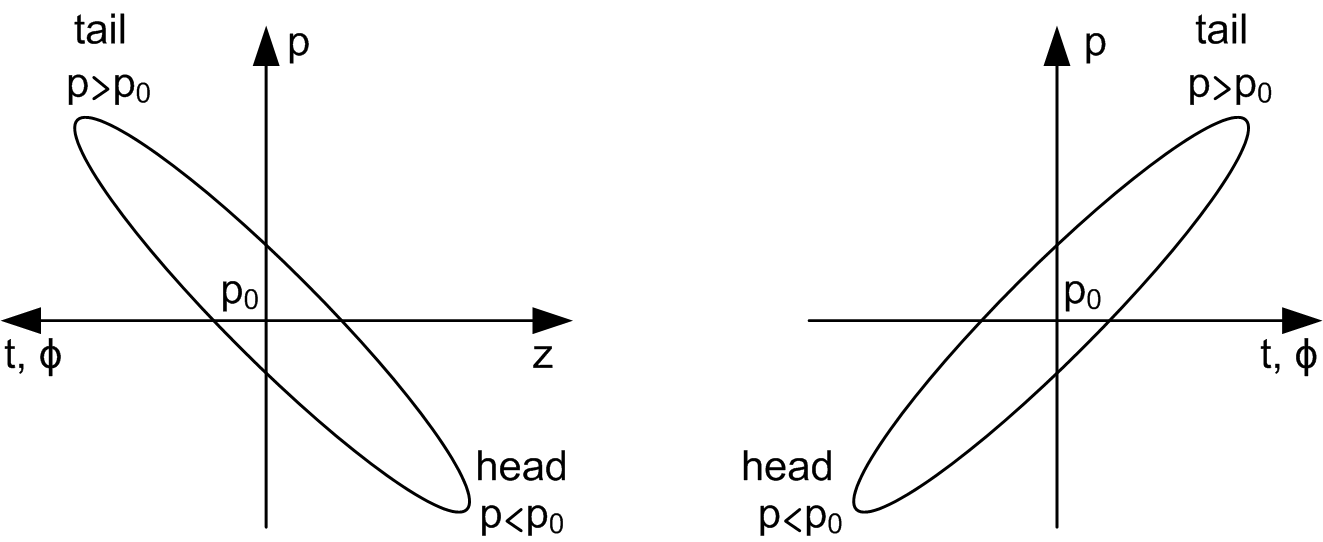Site perso : Emmanuel Branlard
- 3.2.1 Phase space
- 3.2.2 Beam emittance
- 3.2.3 Beam matrix
- 3.2.4 Two dimensional beam matrix - Relation with Twiss-parameters
- 3.2.5 Relation with transport matrix
- 3.2.6 Four dimensional beam matrix - introduction to Emittance exchange
3.2 Beam matrix and phase space
The understand the collective motion of a beam one require the trajectory of each single particle along with its momentum. To fully describe the state of a particle, and to describe it in a representative way, a six-dimmensional space is introduced: the phase space. Nevertheless, the knowledge of this coordinates for each single particle represent too much information, so that only the envelope of the beam is represented in the phase space. In practice, different curvatures can be found in the shape of the beam, nevertheless the canonical form chosen would be an ellipse and its representation by the so-called sigma-matrix.
3.2.1 Phase space
In the theory of beam physics, the three cartesian coordinates are not enough to fully describe the state of the particle, so that a system of 6 coordinates is used:
Two conventions exists for the longitudinal phase space. Indeed, let's consider a particle which is in front of the reference particle in term of the longitudinal coordinate: ![]() . Then this particle will arrive before the reference particle, so its time of arrival is less than the time of arrival of the reference particle:
. Then this particle will arrive before the reference particle, so its time of arrival is less than the time of arrival of the reference particle: ![]() , or in term of phase
, or in term of phase
![]() . This results in two different phase space representations as one can see on figure 3.2. To go from one representation to the other we just have to flip the scheme horizontally. As a result of this, the shape of the ellipse is modified. If one is not careful, this could lead to completly different interpretations while analyzing a phase space sheme. In Astra, an in the rest of this document the ''z convention`` will be used.
. This results in two different phase space representations as one can see on figure 3.2. To go from one representation to the other we just have to flip the scheme horizontally. As a result of this, the shape of the ellipse is modified. If one is not careful, this could lead to completly different interpretations while analyzing a phase space sheme. In Astra, an in the rest of this document the ''z convention`` will be used.

|
3.2.2 Beam emittance
Each particle of a beam is a point in the phase space. The envelope of all these points represents the region occupied by the beam in phase space. This region is called beam emittance, and its value is normalized proportionally to the surface area. In the case of absence of coupling between the different phase plane, three independent beam emittances are defined. In each plane, the region delimited by the particles will be represented by an ellipse for its easy analytical description. The general equation of a 2D phase space ellipse is:The notation
| (3.8) |
The area defined by this two dimensional ellipse is:
 |
(3.9) |
The emittance, for instance in the plane
 |
(3.10) |
Nevertheless, the canonical parameters related to each other are
 |
(3.11) |
The relation between the two is:
| (3.12) |
3.2.3 Beam matrix
The general equation of an ![]() -dimension ellipse can be written as:
-dimension ellipse can be written as:
| (3.13) |
where
 |
(3.14) |
In the context of phase space, a maximum of six dimensions will be used with
3.2.4 Two dimensional beam matrix - Relation with Twiss-parameters
The equation of the phase space ellipse in ![]() -notation is as following
-notation is as following
![$\displaystyle u^T \Sigma^{-1} u = \frac{1}{\det(\Sigma)} \left[ \sigma_{22} x^2 -2 \sigma_{12} x x' + \sigma_{11} x'^2\right] =1$](img244.gif) |
(3.15) |
Let's identify it with the previously introduced equation of the ellipse in Twiss-parameters:
| (3.16) |
The link between these two equation can be obtained by equaling the two ellipse areas:
 and and |
(3.17) |
This leads to the following relation:
One has to be carefull not to be confused between elements of the
| (3.19) | |||
| (3.20) |
3.2.5 Relation with transport matrix
If the transportation matrix from a point 0 to a point 1 is known, then the beam matrix a point 1Given an input sigma matrix, one can try to find which succesion of elements will provide a transportation matrix
3.2.6 Four dimensional beam matrix - introduction to Emittance exchange
To simplify the study of the beam matrix evolution as it propagates through a beam line, we will assume the initial beam matrix to be diagonal by block:
 |
(3.22) |
Emittance exchange is complete if after a tranformation, the output sigma matrix is of the form :
 |
(3.23) |
Writting the transportation matrix ![]() in a general form:
in a general form:
 |
(3.24) |
Equation 3.22 results in:
 |
(3.25) |
Complete emittance exchange is reached if
![]()

